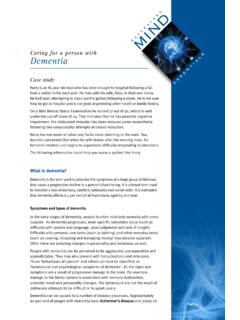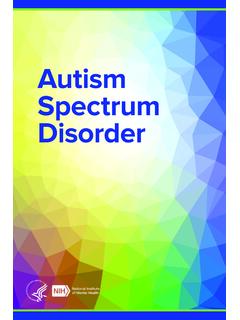Transcription of Clinical Grief Activities - Weebly
1 Clinical Grief Activities for Working with Bereaved Children Providence Hospice of Seattle safe Crossings Children and Teen Grief Support Program 425 Pontius Ave N, Ste 300 Seattle, WA 98109 Clinical Grief Activities for Working with Bereaved Children Introduction: Each of us will face the death of a loved one at some time in our lives. As adults, we seek help from family, friends, and outside supports during the Grief process. But who helps a child cope with the death of a loved one? Children naturally turn to other significant persons in their life for support. Although children may understand and respond to illness and death differently than adults, helping a grieving child is not that different from helping a grieving adult. As a clinician, your interaction can have an important impact in helping a child deal with a loved one s illness and death in a healthy way.
2 The content of this publication is intended to provide clinicians with guidance in providing support to adult caregivers when they are faced with the task of communicating with their children about death and dying. In addition, the concrete suggestions provided in the Clinical Grief Activities will prove beneficial to those clinicians working directly with grieving children. Talking with Children about Death and Dying Important questions to consider when working with bereaved children and their families: What has the child been told about the illness and/or events of the death? What is the family s comfort level with the child knowing details about the illness and/or death? What is the culture in the family regarding illness, death and sharing difficult things with children?
3 What is the child s history with death? Has the child experienced other family member, friends and pet deaths? What are the family and child s past coping responses related to illness and death? If the person who dead did not live in the same home as the child, when was the last time the child saw this person? What was the significance of the relationship to the child of the deceased love one? If the family has not yet talked with the child about circumstances of the Always consider the culture of the family, including ethnic and religious beliefs and practices. Educate that the child may overhear conversations and imagine things that are far worse than the truth. Children may also be picking up on the emotional atmosphere in the home and the changes in lifestyle that have occurred as the family has adjusted to the illness and death.
4 Guidelines to Share with Adult Caregivers about How to Talk with Children When a Death Has Occurred: A primary concern of adult caregivers is often centered on what information to share with children, and how to initiate difficult conversations. The following simple guidelines can assist the caregiver in honoring their children with truth, to the best of their ability. It is helpful to acknowledge that there is not a right or wrong. The guidelines provided are adaptable to the specific context of the family, its values, and the unique personality of the child. Inform the child using simple details. Give general details of how the death occurred. You can begin the conversation by saying, Something really hard happened Sudden death: Dad s heart stopped beating today, and he died.
5 Accident: Mary was in a car accident. Her body was very badly hurt, couldn t be fixed, and she died. Old age: Grandma had gotten very, very old, her body stopped working and she died. Terminal illness: Because the disease couldn t be stopped, your dad got very, very sick and his body stopped working. Dad died. Stillbirth: Sometimes something causes a baby s body to stop working before it is born. We don t know why, but it is nothing anyone did or didn t do. Homicide: Your mother was killed today. Sometimes people do very bad things that hurt or Suicide Absolute (when there is no doubt the person killed him/herself): Your brother killed himself. Sometimes a person s mind gets very sick and doesn t work right, and they don t understand things clearly. They may think the only way to solve their problems is to stop living, so they kill themselves.
6 However, this is never a solution to problems. The only reason they thought of it is because their mind was too sick to think clearly. It s not anyone s fault that this has happened . Suicide Questionable: Sometimes people take pills to relax or to sleep. Sometimes they forget how many they have taken and think that they need more. These pills make their body slow down, and too many of them make their body stop working. We don t think Auntie wanted to die, but that s what happened to her body. Allow questions and answer them truthfully. Children process information concerning a traumatic death in small increments. Depending on the developmental maturity of the child, he/she may ask for graphic details. Answer the question asked as simply as possible.
7 In the case of questions about a murder, it is helpful to refer to the person who committed the act as the killer instead of a very bad person. Mary was shot by a killer. Children are often repetitive, asking the same questions over and over. Again, keep answers simple as well as consistent. This helps to build trust and reassurance that you will continue to tell them the truth. Reassure the child that they are loved. Acknowledge the significance of the relationship and the impact the death will have on the child. Your father loved us very much. I will be here to take care of you. Often children become afraid that another caregiver may die too. It is helpful to reassure a child. Most people do live for a long time. I plan to continue taking good care of myself.
8 Causation. It s important that children are reassured that they are not at fault, especially if the death involves an accident that they may have seen or been a part of. Sometimes horrible accidents happen. There s nothing that anyone could have done to change what happened. Talking to children Sadness: Children need to know why others in the family are sad. Children must be told that it is the death that has made their family members sad. Without an explanation, children may think the sadness is caused by something that they did or said. Start by A very, very sad thing has or Mommy and Daddy are sad Modeling of sad feelings and behaviors lets children know that it s okay to be sad. Children also need to be taught that people express sadness in different ways (ie some may cry, some may want alone time, some may share more than others).
9 What the word dead means: Provide children with basic information about the human body to assist in understanding of alive vs. dead ( , heart stopped beating, lungs no longer breathe in air, brain does not think anymore). Use language and ideas appropriate to the age of the child to communicate that a dead person s body can t do the things it used to do. The body is no longer able to talk, walk, move, see or hear. The dead person no longer feels pain, sadness, anger or discomfort. Use the words dead and died. Avoid the use of euphemisms such as passed away, left us, and gone on. To a child, this may sound as if the person is taking a trip, doesn t want to return and can cause him/her to fear that others may leave and not return. Refer back to these biological explanations when answering a child s questions that arise, such as: o When will she come back?
10 (She can t. She didn t leave; her body stopped working.) o Why doesn t she move? (She can t move because her body has stopped working.) o Why can t they fix him? (Once the body has stopped working, it can t start again.) o Is he sleeping? (No. When we sleep our body is still working, our heart is still beating, our lungs are still breathing and we are just resting.) o Can they hear me? (No. They could only hear you if their body was working.) Funeral/memorial service: If the service has been planned and after a thorough discussion, it is recommended that the child is given the choice to attend. Answering questions that children have will help them to feel welcome, but some children will still opt not to attend. Either choice is ok. It is important to prepare children in advance by telling them as specifically as possible what will happen.



